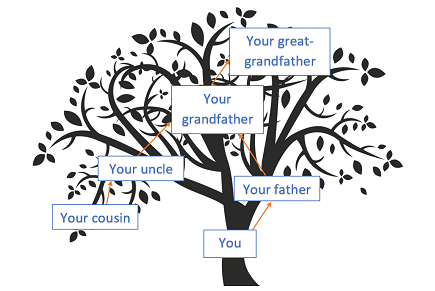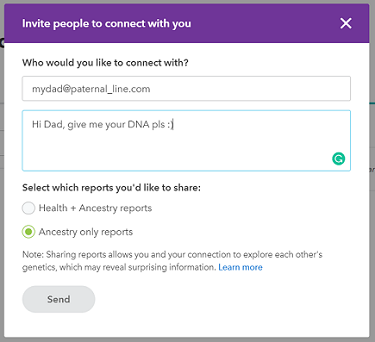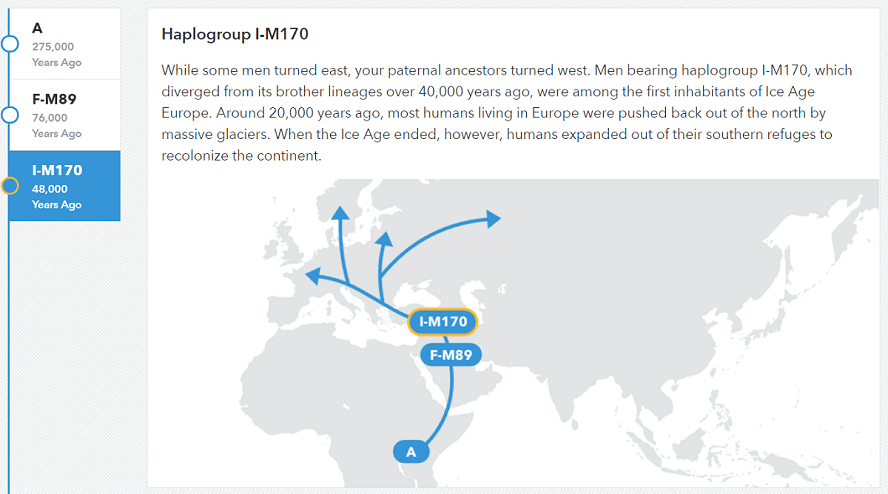Can a woman trace her paternal ancestry?
So, you may have heard that men (or those born biologically male) can trace their paternal ancestry, but that women (and people born biologically female) can’t. This is because paternal DNA testing is done using the male Y chromosome, which women lack. However, women can still learn about their paternal ancestry by getting a relative that shares the same paternal line as them to take a Y-DNA or paternal haplogroup test.
Your paternal family tree
Biological relatives sharing the same paternal line as you include:
- Your father
- Your brother (of the same father as you)
- Your paternal grandfather (your father’s father)
- Your paternal uncle (your father’s brother, sharing the same father as him)
- Your paternal cousin (a male cousin with the same paternal grandfather as you)
Basically, it’s not enough for the relative to be on your father’s side of the family. They must be on your father’s side, and also share the same paternal lineage (to use a grand word) as him. This is because the Y chromosome used to trace paternal ancestry is passed directly from father to son. If you have a half-brother from a different father, he will have a different paternal lineage to you.
Which paternal DNA test should we choose?
Once you have persuaded your eligible relative to take a paternal ancestry DNA test for you, you’ll want to point them in the direction of a DNA test covering male haplogroups, i.e. paternal lineage.
Family Tree DNA offers all sorts of Y-DNA sequencing packages with varying degrees of complexity and depth. 23andMe also offers maternal and paternal DNA testing as part of their ancestry package. If you and your male relative both take 23andMe tests, then your relative can easily share their male ancestry information with you.
Family Tree DNA is a little more complicated than 23andMe, so if you’re no genetic genealogist and just interested in learning more about your paternal haplogroup, then the user-friendly interface and simple sharing integrations of 23andMe may more suitable.
How to connect with your genetic relatives using 23andMe
23andMe sharing invitation
Once you and your relative have both received your test results, you can privately share ancestry information (and health info, if you wish) with each other. You can connect with a relative using the DNA Relatives tool, or privately by going to the Family & Friends section, and selecting “Your Connections” and clicking “Invite”.
You can also add a paternal relative by going to the Paternal Haplogroup section of your Ancestry report, where you will be prompted to invite a male relative to share ancestry DNA data with you if your haplogroup information is missing.
Once your relative has accepted your request, you can head to the Paternal Haplogroup section to see your results!
So… What will the paternal haplogroup test actually tell me?
Paternal DNA tests look for genetic variations in the Y-DNA of your male relatives to determine which haplogroup they are from. This will show the migratory routes your male line ancestors took out of or within Africa. Y-DNA mutates very rarely, but it is these mutations that allow us to track where certain branches have diverged over millennia.
A 23andMe paternal haplogroup map
Generally, your paternal haplogroups will tell you which group you belong to, which haplogroups your subgroup has diverged from, and where people of your haplogroup are most likely to be found today. Often, the results will include a map showing the migration paths of your ancestors, and give a little information about the regions they passed through and around what time they lived there.
Of course, this is just a fraction of your genealogical story, following only one branch of your family tree, but only your direct paternal and maternal lines can be traced so far back.
What can I do if I don’t have any male paternal relatives?
Okay, well, that’s a tricky one. But hopefully not impossible. Some ancestry tests – 23andMe, AncestryDNA, MyHeritage, and Family Tree DNA – offer a family finder feature, allowing you to discover and contact relatives on both your mother’s and father’s side.
Filtering relatives by father’s or mother’s side using 23andMe
Family finder services use autosomal DNA – DNA inherited from both your mother and father – and so it can be hard to tell which side of your family the relatives you discover are on. This is important, since only relatives who share a direct male line with you will share the same paternal haplogroup as your father.
However, you can narrow down the selection. If your mother is living (and willing to have her DNA tested!), and you connect with her on 23andMe, for instance, you can filter your DNA relative matches to show only those on your father’s side (since relatives shared with your mother will be eliminated).
Finding a male paternal relative on 23andMe is the most cost-effective solution (since neither of you will have to be re-tested by another company). However, you may not manage to find a male paternal relative in the 23andMe database.
AncestryDNA has the largest database of all the genetic-testing companies, and so you are statistically more likely to find an eligible relative in their database than in 23andMe’s database. However, AncestryDNA does not provide information on haplogroups. (We have published an article comparing 23andMe and AncestryDNA here.)
If you don’t want to spend a lot of money being tested by multiple companies, you can upload your raw DNA data from any ancestry site (which allows you to download the file) to GEDmatch, a free online database that allows relatives to connect with each other. This will improve the likelihood of finding a male paternal relative.
Now, bear in mind that if you haven’t got any close male relatives, you’re going to have to do some genealogical detective work in order to piece together how you are related to your third, fourth, fifth or sixth male cousins to work out if you share the same paternal line.
The easiest way to do this may be through Ancestry.com, where you can combine the DNA service with their genealogical records service to work out just how you are related to someone. If it turns out you share a great-great-grandfather via the paternal line, then the two of you will share a paternal haplogroup. (Though Ancestry’s genealogical services do come with a subscription.)
Alternatively, you may find a relative on one of the major ancestry sites or GEDmatch who has created a family tree. This can help you work out how you are related to them and the other relatives you find. If you are serious about tracing your paternal DNA, you’ll probably want to create your own family tree (or at least one following your paternal line) so that you can be sure the relatives you find really are descended from the same haplogroup as your father.
Does this sound like a lot of trouble? It probably will be! But if you’re really curious about tracing your paternal line, you may want to go to these lengths to track down a male relative that can take the test for you, and discover which haplogroup your ancestors belonged to.

devjani
March 11, 2019
very informative,thanks